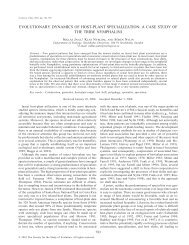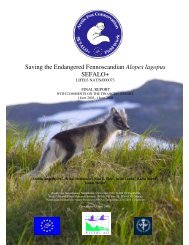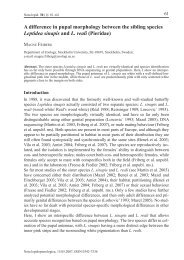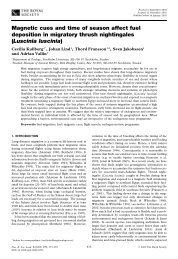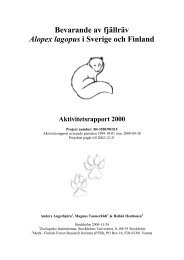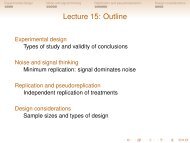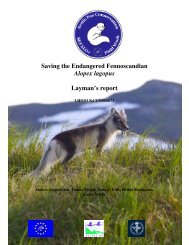The conservation of Fennoscandian arctic foxes - Stockholms ...
The conservation of Fennoscandian arctic foxes - Stockholms ...
The conservation of Fennoscandian arctic foxes - Stockholms ...
You also want an ePaper? Increase the reach of your titles
YUMPU automatically turns print PDFs into web optimized ePapers that Google loves.
Table 3. Linear regression results for the number <strong>of</strong> reproducing <strong>arctic</strong> <strong>foxes</strong> in five Swedish areas (1980-2006)tested against: A: the no. <strong>of</strong> shot red <strong>foxes</strong> during previous winter, the estimated number <strong>of</strong> red <strong>foxes</strong> and rodentdensity (no. per 100 trap nights), B: the no. <strong>of</strong> shot red <strong>foxes</strong> during previous winter, and the number <strong>of</strong> denswith supplemental feeding during the winter.A.Factor Beta t P nNo. <strong>of</strong> red <strong>foxes</strong> 0.01 0.06 0.95 54Rodents (no./100trapnights) -0.22 -1.25 0.23 28No. <strong>of</strong> red <strong>foxes</strong> shot 0.73 4.16 0.0006 42BFactor Beta t P nNo. <strong>of</strong> fed dens 0.43 3.31 0.0018 51No. <strong>of</strong> red <strong>foxes</strong> shot 0.40 3.05 0.0037 511816No. <strong>of</strong> occupied <strong>arctic</strong> fox dens141210864200 10 20 30 40 50 60 70 80 90No. <strong>of</strong> shot red <strong>foxes</strong>Figure 4. <strong>The</strong> number <strong>of</strong> annual <strong>arctic</strong> fox reproductions increased with the number <strong>of</strong> red <strong>foxes</strong> shot in Helags,Borgafjäll, Vindelfjällen, Sitas, Raustojaure (1999–2006).So far our results demonstrate a clear effect <strong>of</strong> both hunting and feeding on the number <strong>of</strong> reproducing<strong>arctic</strong> <strong>foxes</strong>. However, we were also interested in the quantitative effect <strong>of</strong> our actions on the <strong>arctic</strong> foxpopulation. In some areas, we have managed to conduct intensive feeding and intensive red foxhunting (Helags and Borgafjäll SE) whereas in other areas the actions have been less intensive. InFigure 7. the synchrony in the <strong>arctic</strong> fox population in different areas is obvious with a peak in strongincrease in 2001 and 2005. As is argued above, the increase years are <strong>of</strong> greater interest and our focusis thus on comparing the effect <strong>of</strong> both hunting and supplementary feeding in Helags and Borgafjäll(Appendix 1), with those <strong>of</strong> minor or no actions at all during the increase years (i.e. 2001, 2004 and2007). We found that the number <strong>of</strong> <strong>arctic</strong> fox litter has been doubled during each rodent cycle in theseareas (Figure 8.). In the Helags area, the number <strong>of</strong> <strong>arctic</strong> fox litters increased from two litters 2001 t<strong>of</strong>our and nine in 2004 and 2007 respectively. In Borgafjäll area the trend was from 0 to five and ninelitters during respectively years. In all the other areas we saw no change in the number <strong>of</strong> litters(Figure 8.). Accordingly, the <strong>arctic</strong> fox populations in the areas with intense management actions (i.e.9



